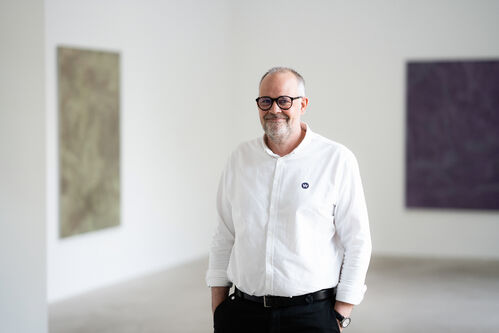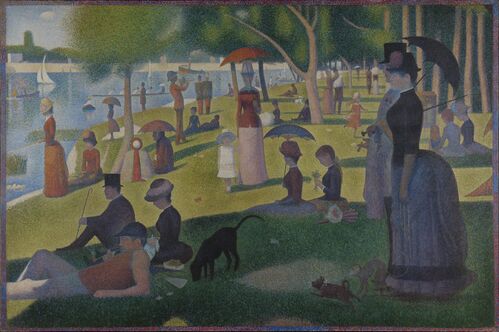
A Sunday on La Grande Jatte, 1884-1886
Georges Seurat
Art Institute of Chicago
When Georges Seurat debuted A Sunday Afternoon on the Island of La Grande Jatte at the 1886 Impressionist exhibition in Paris, the reaction was far from positive. Art critic Arsène Alexandre coined the term “Pointillism” with a sneer, mocking the artist’s obsessive application of tiny dots of color. To skeptics, Seurat’s bathers and bourgeois strollers seemed stiff, even lifeless—as if his precision had drained the painting of humanity.
Yet Pointillism has always been more than the sum of its parts. Seurat and fellow Neo-Impressionist Paul Signac were responding to new color theories and ideas about visual perception, proposing a style that imposed order on the loose, spontaneous brushstrokes of their Impressionist predecessors. Rather than blending colors, they split images up into discrete, unmixed points of pigment, allowing the viewer’s eye to do the mixing. The effect, when successful, increased the paintings’ luminosity: Dots of pure colors, when juxtaposed, mutually reinforced the others’ brilliance. Perception, these painters seemed to suggest, was subjective and fragmentary.
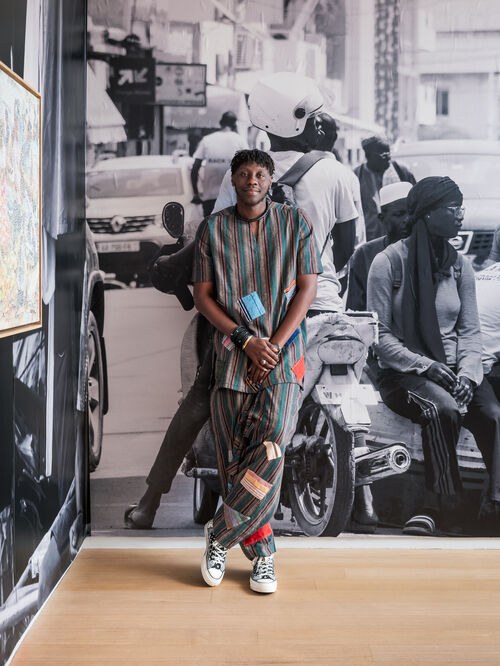
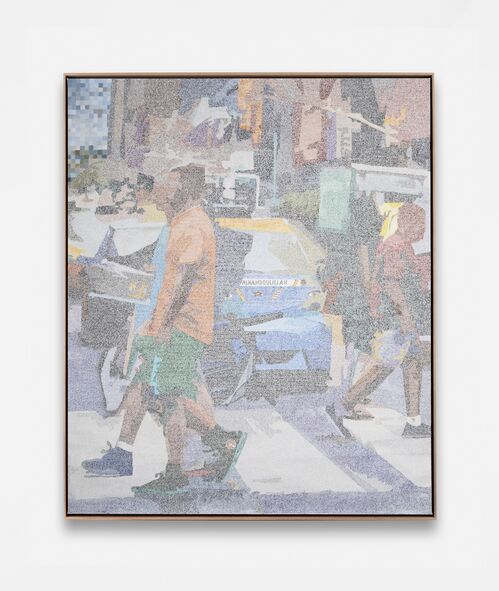
Today, a new generation of artists is revisiting Pointillism, embracing its visual language and expanding its conceptual underpinnings. No longer solely about the science of perception, Pointillism has become a tool for exploring identity, memory, history, and materiality. These Neo-Pointillists have adapted the techniques used by Seurat and his peers in service of more layered and wide-ranging meanings, breaking down their images as a means of inquiry.
One such artist is Alioune Diagne, a 39-year-old Senegalese painter who borrows methods learned from his grandfather, a teacher of the Quran, to transform scenes of everyday life into meditations on history and culture. Instead of dots, Diagne’s works use small, meticulously painted calligraphic symbols as building blocks for large-scale figurative depictions of Black communities. At a distance, his painting All Voices (manifestations) (2024), for instance, depicts a crowd of protesters calling for “power to the people.” Up close, it dissolves into an impenetrable codex of signs that represent no specific language while evoking written letters.“These signs convey emotions, memories—everything intangible,” Diagne told Artsy.
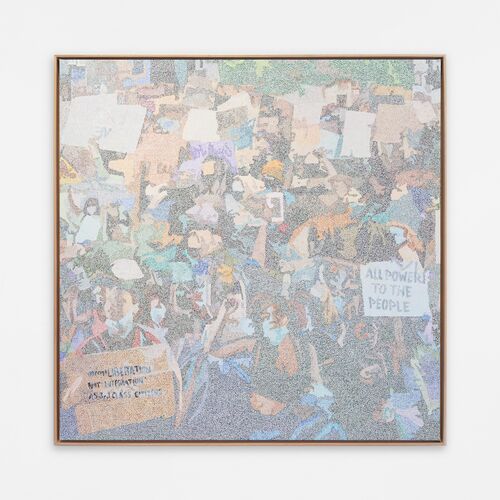
All Voices (manifestations), 2024
Alioune Diagne
Templon
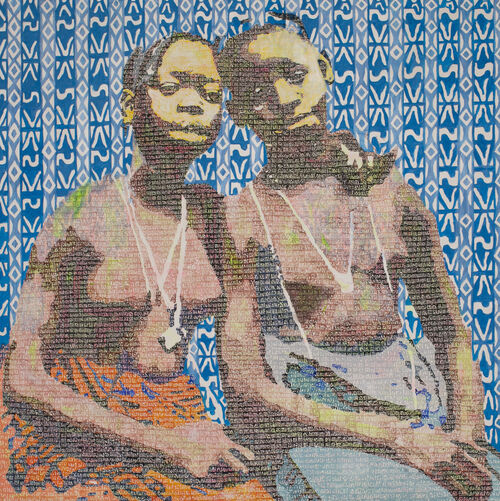
Filles de Dakar, 2019
Alioune Diagne
We Art Partners
By depicting modou-modou—Senegalese workers who have moved away from the countryside and settled in major cities to support families they left behind—and moments of everyday life in Dakar, the artist creates a “living archive” that captures the complexity of cultural identity. His Pointillist forms aren’t about visual illusion, but about bearing witness. He combines his meticulous abstract symbols with “other, more explicit forms of writing: protest slogans on placards, inscriptions, newspaper collage, or symbols drawn from Senegalese culture,” he said. “Everything carries meaning. Nothing is there by chance. It’s my way of saying that behind every detail, every sign, lies a message or a fragment of memory.”
If Diagne employs Pointillist techniques to preserve living histories, Indigenous Australian artist Daniel Boyd uses them to reexamine the past. His paintings, often based on archival imagery, are made up of protruding dots of clear glue layered on top of oil paintings. “Each point is a transparent lens,” Boyd told Artsy. “It’s about perception and multiple points of view…an opportunity to give the audience a different sense of authorship when they stand in front of the works.”
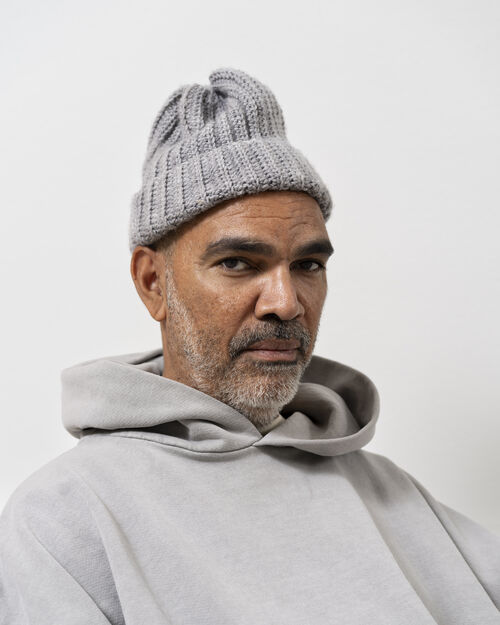
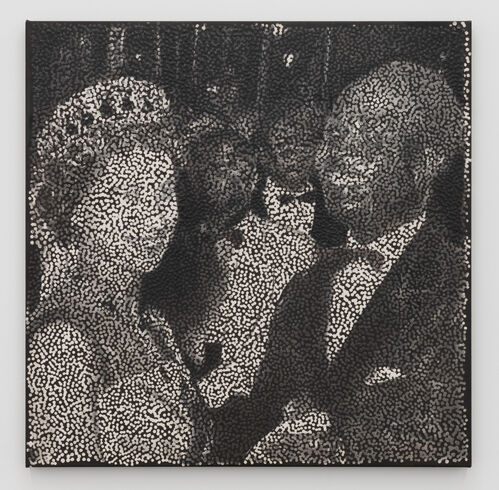
Untitled (INYIM), 2021
Daniel Boyd
STATION
Rather than presenting a complete image for the viewer, Boyd invites his audience to navigate gaps and distortions—what’s visible and what’s missing. Gestalt psychology, a 20th-century school of thought suggesting that the human brain fills in gaps to create a whole image, is a conceptual backbone of Boyd’s practice. When we look at an incomplete image, “we automatically fill in those gaps and create something,” said Boyd. His work asks, “How do we let the thing be without projecting too much onto it?”
Boyd’s interest in this perceptual framework relates to his own educational experience. Growing up in Australia, he often felt that the history he was taught excluded his Aboriginal culture entirely. “The narrative that was presented didn’t involve me and my people,” he told Artsy. By connecting Gestalt principles to these omissions, Boyd uses his work to question what is shown, what is not, and how the gaps leave room for historical distortions.
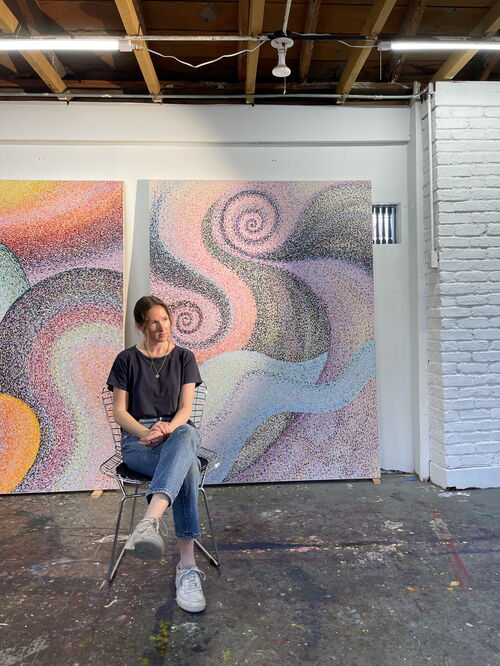
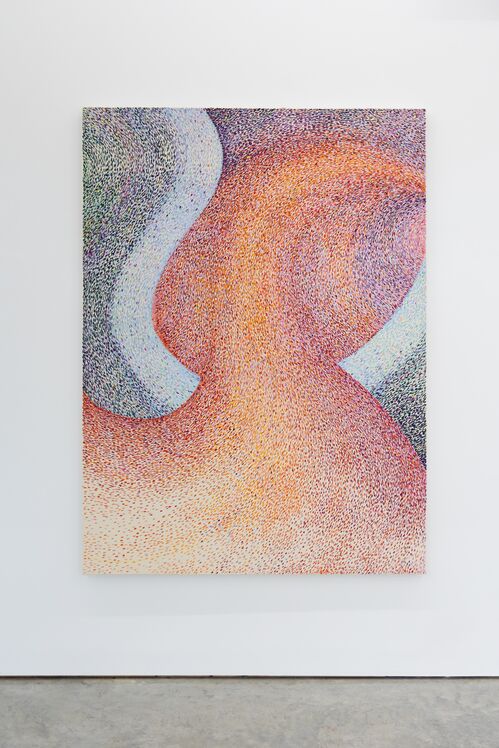
Boyd is attuned to the legacy of British colonialism beyond his own country. For instance, his painting Untitled (INYIM) (2021) is based on an archival image of Queen Elizabeth II dancing with Ghanaian political leader Kwame Nkrumah in the 1960s, which at the time was seen as a symbolic gesture of goodwill and a recognition of Ghana’s independence. However, in Boyd’s work, both faces are nearly imperceptible. The work subtly reflects how imperial power cloaked itself in pageantry while leaving behind fragmented and selective histories.
Los Angeles–based painter Gwen O’Neil’s approach to Pointillism, meanwhile, is more intuitive than critical: She embraces dots to explore the emotional rhythms of the environment. Her large-scale paintings are characterized by a lyrical, kaleidoscopic use of color that evokes a pulsing natural world. Originally a landscape photographer, O’Neil turned to painting as a way to capture the atmosphere of Southern California. Her Pointillist marks break down the landscape into its simplest parts, creating dense constellations of pigment that abstract familiar scenery into fields of color and motion.
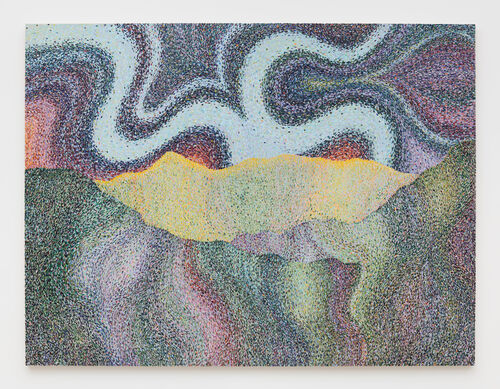
In Wild Mountain Thyme (2023), for instance, gold ridgelines blaze against a sky that pulses with violet and blue spirals, as if the landscape itself is vibrating. Dots of purple, orange, green, and blue ripple across the canvas, giving the terrain a sense of constant transformation, whether from wind, water, or heat rising from sun-scorched ground. In “A Glimmer in the Shade,” O’Neil’s recent exhibition at Almine Rech in New York, her paintings drew inspiration from the Santa Ana winds.
Coincidentally, that exhibition coincided with the devastating wildfires that spread across Los Angeles in January, fueled by the Santa Ana winds. Through their attentive rendering of nature’s vibrancy and volatility, O’Neil’s paintings also advance a message about the environment. “I want to share the beauty and the fragility of the natural world,” O’Neil told Artsy. “Painting in this way allows me to do both. These deceptively ‘pretty’ paintings are a gentle reminder of what we are going to lose unless we protect our environment.”

New York–born painter Jessica Cannon, too, draws on natural beauty in her Pointillist-esque work. She doesn’t paint with spots, but her work still evokes the style. “Sometimes people think I work with dots,” she said, “but the part that might be seen as dots is actually one of the layers underneath a veil of mark-making.” In Night Pleats (Triptych) (2023), for example, radiant bands of pale violet fan out like beams of moonlight, while soft circular forms hover above a snowy white ground. Cannon arrives at this pixelated effect by delicately layering paint over luminous bases.
Cannon generally works in a more introspective register. Her fragmented paintings build spatial ambiguity, encouraging the viewer to pause, adjust, and look again. Darker strokes sit atop luminous grounds, producing a subtle backlit quality that feels atmospheric and calming. Her work extends “an invitation to viewers to be present in their subjective experience of being alive and looking at something,” she told Artsy from her Brooklyn studio.

Night Pleats (tryptich), 2023
Jessica Cannon
Gavlak
South Korean artist Ilhwa Kim, meanwhile, pushes Pointillism into three dimensions, taking materiality itself as her subject. Her wall works are constructed from thousands of hand-dyed paper units she calls “seeds,” each one rolled, cut, and shaped by hand before being individually organized. She gently places the pieces into tight clusters before gluing them together. From a distance, the works seem to hum, evoking the optical vibrations that Seurat sought. Up close, they shift: The surface becomes topographical.
Kim’s methodology offers a materially inventive version of Pointillism’s core aim: stimulating perception through repetition and relation. “Every single paper unit…plays as a sculpted brush stroke,” she said. In Territorial Matter (2024), spirals of pale green and blue seeds undulate across the surface, interrupted by rhythmic pulses of coral and lavender. The work suggests a forested, mountainous landscape from a bird’s eye view. For Kim, as for her Pointillist predecessors, the contrast between discrete elements is key. “My work does not hide or erase the individual live presence of all the surface units,” she said.
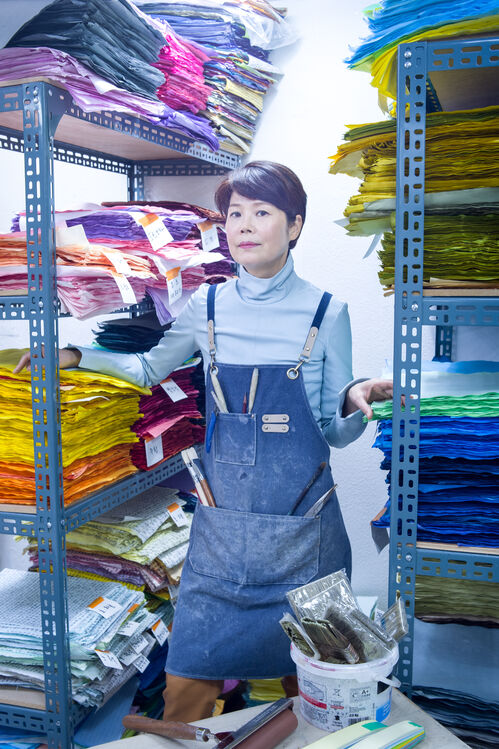
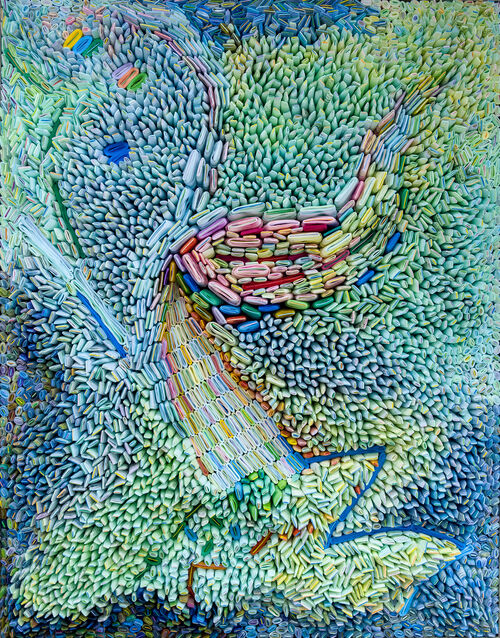
Birth of a Tear, 2024
Ilhwa Kim
Maybaum Gallery
The Pointillists’ fragmentary approach responded to late 19th-century advancements in the study of perception. But, in a way, it’s perfectly suited to the contemporary moment, when the world around us seems so irrevocably fractured—our attention spans, our politics, our connection to the environment, our historical memory. While they represent a wide range of cultures and artistic concerns, today’s Neo-Pointillists are all finding the technique to be an effective tool for expressing their individual points of view.

